Download PDF
Are you pondering the possibility of adding aesthetics to your practice? Short of bringing in an oculoplastic-trained surgeon and providing the capital support that this type of aesthetic practice requires—decidedly the best route according to some experts—you might wonder if you can do it yourself. The proliferation of neurotoxins, fillers, and laser technology may make this an intriguing prospect for some ophthalmologists.
While the benefits, including new revenue streams and cash-paying patients, might sound enticing, the reality is that adding aesthetics may require that you change your practice management patterns, alter staffing, and potentially renovate waiting and patient treatment rooms, said oculoplastic surgeon Jill A. Foster, MD, medical director of Plastic Surgery Ohio in Columbus.
And on the clinical side, you will need to learn an array of new skills and technologies. Dr. Foster suggested that comprehensive ophthalmologists interested in expanding into aesthetics ease into the field starting with the basic neurotoxins and then slowly adding fillers and lasers.
“Ophthalmologists must be aware that there is a learning curve, both in acquiring new skills and in terms of managing patient expectations,” Dr. Foster said. “The cosmetic patient is more demanding and is paying up front for an expected result. Physicians must be clear about what they can and cannot do in order to meet patient expectations and satisfy patient desires.”
She added that expanding into aesthetics is a multifactorial decision involving science, artistry, practice management, and financial considerations.
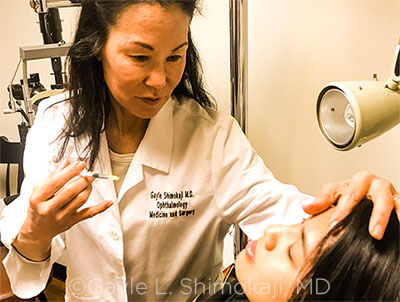 |
|
BOTOX. Dr. Shimokaji is about to give one of her patients a Botox treatment.
|
Neurotoxins
Neurotoxins are a common and essential component of aesthetic rejuvenation, Dr. Foster noted.
History. The U.S. Food and Drug Administration (FDA) approval for onabotulinumtoxinA (Botox) in 1989 for treatment of strabismus and blepharospasm was followed in 2002 by FDA approval to treat glabellar lines, which expanded aesthetics beyond the realm of oculoplastic surgeons. And Gayle L. Shimokaji, MD, of 2020 Ophthalmic Consultants in Greenbrae, California, was there from the beginning. She worked closely with a pioneer of Botox, Alan Scott, MD, in the late 1980s at California Pacific Medical Center in San Francisco, where they were injecting botulinum toxin to treat blepharospasm and strabismus.
“When I started to inject patients for blepharospasm and they returned for follow-up looking amazing, I knew we were onto something,” Dr. Shimokaji said. “It became FDA approved for frown lines in 2002 and, just in October 2017, the FDA approved Botox for forehead lines.”
Dr. Shimokaji noted that 30 years later, the demand for Botox continues to be strong, even among her older patients. “I have added a wide array of fillers, dermal stimulators, skin-rejuvenating products, and lasers, so that my office is a practice where you can have your cataracts removed and look terrific.”
Three neurotoxins. After approving Botox, the FDA approved abobotulinumtoxinA (Dysport) in 2009 for treatment of glabellar lines and incobotulinumtoxinA (Xeomin) in 2010 for blepharospasm and facial wrinkles. While the drugs share the same mechanism of action, dosing varies.
In a comparative assessment of the literature that included a systematic review with meta- analyses, researchers found a benefit of the 3 neurotoxins over placebo for facial rhytides, with inconclusive findings of superiority. Only high-dose onabotulinumtoxinA (compared with a standard dose) offered additional benefit at 30 days.1
Shift in usage. The Global Aesthetics Consensus Group identified a paradigm shift in neurotoxin treatment toward neuromodulation rather than paralysis of target muscles.2 Dr. Foster said this is accomplished by customizing the volumes and dose for different locations on the face, varying the locations by how the individual moves those target muscles, and taking into account the patient’s sex and muscle mass. The depth of injections can also impact the results of the treatment in the forehead and lower eyelids.
In addition, the use of botulinum toxin has expanded from the upper face to treating the lower face, neck, and midface. “We take a panfacial approach, making anatomy-based decisions involving the forehead, glabella, nasalis, orbicularis oculi, and depressor anguli oris,” Dr. Foster said. “Treatment planning is highly individualized—the patient is a partner in how we proceed.”
Scars. Additional uses for neurotoxins include the treatment of hypertrophic scars (except keloid scars), which improves the scar’s appearance by relaxing muscle tension, inhibiting fibroblast proliferation in the wound, decreasing production of inflammatory cytokine transforming growth factor, and increasing expression of vascular endothelial growth factor (VEGF). “Faster vascularization and more rapid re-epithelialization of the wound result in a smaller scar,” Dr. Foster said.
Combination treatments. “Synergistic treatments potentially used with neuromodulators include dermal fillers, resulting in an increased effect on flattening wrinkles as well as a greater duration of effect; laser/light-based energy, enhancing efficacy for fine lines, wrinkles, and erythema; and skin care products that promote collagen synthesis,” she added.
How to use. Brett S. Kotlus, MD, a Manhattan-based oculoplastics specialist who is board certified in ophthalmology and cosmetic surgery, advised, “For comprehensive ophthalmologists interested in expanding into aesthetics, mastering neurotoxin injections for on-label indications is the first step. Start with basic treatment such as glabella, crow’s feet, and forehead lines.”
Once ophthalmologists are comfortable with these indications, said Dr. Foster, they can use neurotoxin injections off-label to address neck bands (platysma), smokers’ lines (orbicularis oris), gummy smile (levator labii), nasal tip (depressor septi nasi), and chin dimples (mentalis).
To gain skills with neurotoxins and other modalities, Dr. Kotlus suggested attending hands-on courses and cosmetic medical meetings, purchasing video series, and doing a preceptorship—or, “even better, a cosmetic fellowship with an expert.”
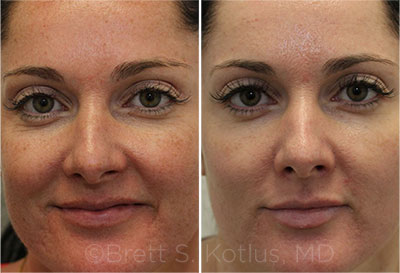 |
|
WRINKLES. This patient received Dysport for crow’s feet, plus a skin care regimen.
|
Dermal Fillers
While the effects of neurotoxins last from 3 to 6 months, the effects of dermal fillers range from 6 months to 3 years, and they are usually used for volume enhancement.
Types of fillers. Dermal fillers can be categorized into temporary, semipermanent, and permanent. FDA-approved uses for dermal fillers include treatment of moderate to severe nasolabial folds, cheek and lip augmentation, and increasing the volume of the back of the hand.
Reversible fillers. “Ophthalmologists starting out with injectable dermal fillers should use products that are reversible, such as gel fillers,”Dr. Kotlus said.
Hyaluronic acid fillers are the most popular type of gel filler, Dr. Kotlus said, and they help restore the appearance of volume and elasticity. The most widely used reversible fillers are the Juvederm family of products, Restylane family of products, and Belotero Balance, he added. In addition, he noted that off-label uses include filling in hollowness in the temples, brow, jawline, or tear troughs.
Semipermanent fillers. Semipermanent fillers are also referred to as biostimulatory fillers, stimulating the body to form its own collagen around the injected filler substance to increase volume. The most commonly used semipermanent filler in the United States is Sculptra, Dr. Kotlus said.
Permanent filler. The FDA has only approved one permanent injectable filler, Bellafill, indicated for correction of the nasolabial folds.
How to use them. Dr. Kotlus noted that while an abundance of fillers is available, using them successfully requires following an approach that encompasses both strategies and tactics.
“If you don’t have a strategy, how can you solve a problem?” he asked. “In aesthetics, the strategy refers to the patient’s concerns and the broad idea of what you are trying to accomplish to solve that concern. Tactics are the specific tools to serve that strategy. If you just have a tactic without a strategy, there is no direction for your tools.”
Dr. Kotlus gave some examples.
Strategy: Reduce nasolabial shadows. Tactics: Injectable fillers, subdermal placement.
Strategy: Restore volume loss to cheeks. Tactics: Large particle injectable filler in mid/upper cheek.
Strategy: Minimize malar mounds and nasaolabial creases. Tactics: Submalar nasolabial filler plus barbed PDO (polydioxanone) threads.
“Using this ‘strategy and tactics’ approach gives you a framework for how to approach the patient,” said Dr. Kotlus. “If you don’t have a system in place, you are reinventing the wheel with every patient.”
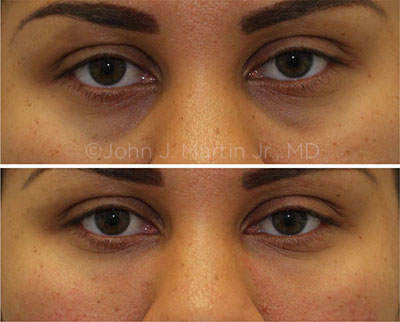 |
|
TEAR TROUGHS. Off-label Restylane and Restylane Lyft were used for this patient’s tear troughs.
|
Lasers and Other Technology
Once comprehensive ophthalmologists introduce neurotoxins and fillers into their practice, they may want to consider the next step: lasers. It is a move that should not be taken lightly, according to John J. Martin Jr., MD, in private practice in Coral Gables, Florida. “When considering lasers, ophthalmologists really must make a commitment,” he stressed. “You have to use the machine on a regular basis, not just once a week, and maximize the results to keep patients happy.”
Dr. Martin also noted that there is a significant learning curve. “Some companies will give doctors a hard sell, saying utilizing lasers is a piece of cake and a great, easy way to make money,” he said. “Nothing could be further from the truth.” The complexity of the lasers and the process of choosing the right laser, selecting the appropriate patients, and avoiding complications must be considered when introducing lasers into a practice.
CO2 laser. Dr. Martin noted that CO2 was the first laser used for resurfacing, and it is still considered the gold standard for fully ablative resurfacing to rejuvenate the skin. On the downside, the recovery time for ablative resurfacing is relatively long (2 weeks), and there are several possible complications, including scarring, hypopigmentation/hyperpigmentation, infection, and prolonged erythema.
Because of the possible changes in pigmentation postoperatively, it can only be used on fairer skin tones, Dr. Martin pointed out.
Erbium laser. The other fully ablative resurfacing laser is the erbium. While the erbium laser does not produce as much tightening as the CO2 laser, it has the benefit of a shorter recovery time, about 1 week.
Fractionated ablative resurfacing. “One of the biggest advances in the last few years has been the introduction of fractionated ablative resurfacing for both CO2 and erbium,” Dr. Martin said. “With fractionated resurfacing, microscopic zones of the skin are ablated instead of removal of the whole epidermis.”
He explained that leaving normal skin around the treated skin allows for faster healing, with less redness, and decreased risk of pigmentation changes postoperatively. This laser can be used on the face, and, at lower powers, it can even be used cautiously on the neck, chest, and hands. “There will not be as much skin tightening as can be seen with the fully ablative CO2 and erbium, but the fractionated lasers have become the lasers of choice for most resurfacing procedures due to the better safety profile,” he said.
Intense pulsed light. For physicians who are just beginning to treat the skin, intense pulsed light (IPL) can give excellent results, said Dr. Martin. It’s not a laser but a high-output flash lamp that has been used to treat vascular and pigmented lesions as well as epidermal and dermal atrophy associated with photoaging and other imperfections.3 “There is minimal downtime for the patient and significantly less risk of complications than with the ablative lasers,” Dr. Martin said.
“This device has been a workhorse for us,” he added. “It helps decrease dark circles under the eye, redness, pigment spots, and the appearance of scars, while helping rejuvenate the skin with fewer complications. It is important to stay beyond the orbital rim, and the surgeon and patient will need eye protection—goggles and shields—when this device is in use.”
Two recent options. Newer options include microfocused ultrasound, which is a transcutaneous heat delivery modality that reaches the deeper subdermal connective tissue and is used to tighten the neck. And microneedling with radiofrequency, a handheld device that sends radiofrequency energy to subdermal tissue to stimulate the body’s natural collagen and healing processes, is useful in treating acne scars and wrinkles.
About his practice, Dr. Martin said, “We are doing more laser treatments than we used to because a lot of people don’t want surgery. These devices are an investment, so you need to choose wisely. I would suggest talking to colleagues and spending time with their technology to see what is the best alternative for you.”
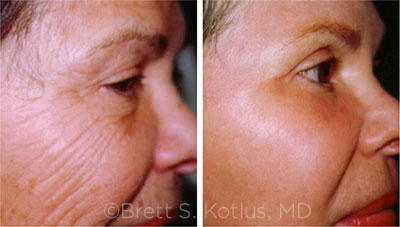 |
|
CO2. Patient who underwent CO2 laser treatment in Dr. Martin’s practice before (left) and 5 months after the procedure (right).
|
Practice Management and Marketing
For comprehensive ophthalmologists who are interested in introducing aesthetics into their practice, Dr. Shimokaji’s advice is to shadow a fellow ophthalmologist who has successfully done so. Specifically, she advised focusing on learning how the office functions in terms of managing patient expectations, patient flow, up-front costs, and marketing.
Patient expectations. Dr. Kotlus pointed out that expectations are different for patients seeking cosmetic treatment. “First, they are spending money out of their pocket rather than using insurance, so they expect a high level of care. Second, aesthetics is considered a luxury service, and attention should be given to patient’s needs. I think it is nice to have an office that is suitable for the cosmetic patient, including a well-appointed, comfortable waiting area.”
Dr. Martin added that patients often desire a smaller, more intimate waiting area and possibly a backdoor entrance for added privacy. “It is a different environment for these patients,” he said. “They are paying cash and don’t want to be herded through the office.”
Patient flow. Dr. Shimokaji explained that patients should be given the opportunity to express what they want in terms of aesthetic procedures. “You need to ask the patient, ‘What is bothering you?’ Even though the patient may have wrinkles on her forehead, if she replies that her smile lines have always bothered her, then you need to focus on her smile lines.”
Treating aesthetics patients is about “less volume, more intensity,” Dr. Foster said. Ophthalmologists spend more time talking about options and potential treatment plans. “Instead of a 15-minute visit, you may need an hour for a new patient,” she said. “The first visit often covers more than one aesthetic concern with multiple alternatives of treatment that should be discussed. In addition, some new patients want to be treated that same day, so your schedule and staffing must be flexible enough to accommodate these needs.”
Dr. Kotlus also mentioned the importance of giving patients your full attention and “not rushing to get to the next room. They need to know that you are listening to them and understand them.” He recommended hiring a physician extender, either a medical assistant or aesthetician, to help patients maintain their results and discuss lifestyle issues such as the importance of smoking cessation and sun avoidance.
Up-front costs. Introducing aesthetics requires the purchase of unique equipment and supplies. Dr. Foster listed several, including camera/photographic technology, topical skin care products, chemical peels, microdermabrasion products, neurotoxins, soft tissue fillers, IPL/lasers, and non-facial cosmetic technology.
“We added product lines as we could afford them and upgraded once the devices were paid off,” Dr. Foster noted. Financing may be needed if the ophthalmologist opts to acquire lasers and other expensive equipment. “One can find companies that offer daily rental of lasers; this may be a practical solution for the ophthalmologist who wishes to incorporate aesthetics on a part-time basis but not transform his or her practice,” she said.
Dr. Shimokaji uses a wide variety of lasers and other devices including CO2, erbium, IPL, and Ultherapy ultrasound in her practice. She has managed the costs by partnering with plastic surgeons at a local surgery center. She also has leased some lasers, installing them in different rooms in her practice. “I have hired a laser tech, which allows me to become very efficient in my treatment,” she said.
Marketing. Dr. Foster said that marketing efforts begin with current patients. “Potential patients seeking this treatment are already in your office,” Dr. Foster noted. Dr. Shimokaji, who has a busy comprehensive ophthalmology practice, said she has a box on her intake questionnaire asking if the patient is interested in any cosmetic changes. If the patient checks the box, she will introduce and explore options with those patients.
Dr. Kotlus noted that social media and cosmetic websites are excellent marketing tools to reach patients. “When you have an active practice and a base of patients who trust you, then internal marketing such as patient referrals is the most cost-efficient approach. Yet a good percentage of patients find me online. I am seeing a lot more patients coming from Instagram. Twenty years ago, I would have had to walk door to door telling doctors of my services.”
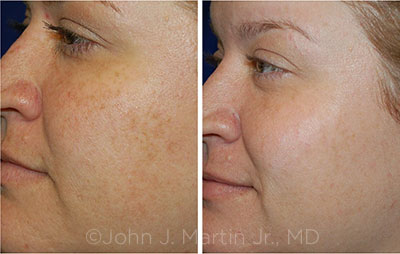 |
|
IPL. Dr. Martin’s patient before (left) and 4 months after intense pulsed light treatment (right).
|
An Evolving Field
Looking ahead, Dr. Kotlus noted that the field of aesthetics is constantly evolving, and “cosmetic procedures have become more accepted among all walks of life, from the working class to professionals, and from younger individuals to older patients.” He anticipated that the field will continue to grow as new technologies are introduced.
___________________________
1 Bonapart JP et al. Plast Reconstr Surg. 2016;137(4):1125-1140.
2 Sundaram H et al. Plast Reconstr Surg. 2016;137(3):518e-529e.
3 Goldberg DJ. J Clin Aesthet Dermatol. 2012;5(6):45-53.
Advice From a Full-Service Cosmetics Practice
Patients who seek a true one-stop shop in terms of cosmetic surgery need look no further than Hass Plastic Surgery in Palm Beach, Florida.
Andrea N. Hass, MD, is an oculoplastic surgeon who, 22 years ago, set up practice with her husband, Brian Hass, MD, a board-certified plastic surgeon, to offer the full spectrum of cosmetic surgery treatment options for patients. They have since added another plastic surgeon, and they divvy up the work: Dr. Andrea Hass focuses on the eyes, her husband focuses on the head and neck, and the third surgeon performs breast and body surgeries.
While the 3 surgeons share staff and overhead, they meet with patients individually, each devising a plan of treatment that they subsequently share with each other. “As an ophthalmologist, I have great insight into the nuances of the periocular anatomy, which gives me an edge over plastic surgeons in this area,” Dr. Andrea Hass said.
Must have vision and skill. While aesthetics is a growing area of ophthalmology, Dr. Andrea Hass cautioned that introducing cosmetic treatments into a comprehensive practice has its challenges.
First, it is vital that the ophthalmologist has an aesthetic eye and can visualize in 3 dimensions.
“Aesthetic treatments involve multiple steps,” she said. “You have to identify where the volume losses are, predict what you can achieve with the fillers, have the mental image of the endpoint, and then communicate this to the patient. It takes experience, training, and the constant pursuit of perfection.”
Must deliver excellent customer service. Second, she said, “the way a general ophthalmology practice is set up is dramatically different from our office. We devote a great deal of time consulting with each patient—a factor that can clog up a general ophthalmology practice.”
Indeed, she said that her practice runs like a “well-oiled” machine, and she credits her practice manager, Veronica Wagner, for running the office —from scheduling to billing to patient education—with an intense focus on customer service. “Our practice is large, and customer service is ingrained in the entire staff,” Ms. Wagner said. “Every single day we do everything we can to make our customers happy.”
Key questions. Before introducing aesthetics into your practice, Ms. Wagner said that you need to answer the following questions:
- How is the office set up in terms of staffing?
- What are the general up-front costs in terms of purchasing equipment/supplies related to aesthetic procedures?
- How will you schedule the doctors?
- What are the business/monetary benefits/challenges of running an aesthetics office (cash patients vs. insurance patients)?
“Introducing aesthetics requires a lot of thought,” Ms. Wagner added. “If you are going to be making the transition, you must be prepared.”
|
Meet the Experts
Jill A. Foster, MD Medical director of Plastic Surgery Ohio, a division of Ophthalmic Surgeons and Consultants of Ohio; head of Aesthetic Services at The Eye Center; and associate clinical professor of ophthalmology at The Ohio State University. All positions are in Columbus, Ohio. Financial disclosure: Mallinckrodt: C.
Andrea N. Hass, MD Oculoplastic surgeon and cofounder of Hass Plastic Surgery in Palm Beach, Fla. Financial disclosure: None.
Brett S. Kotlus, MD Oculoplastic surgeon who is also certified by the American Boards of Ophthalmology and Cosmetic Surgery. In private practice in New York City. Financial disclosure: None.
John J. Martin Jr., MD Oculoplastic surgeon in private practice in Coral Gables, Fla. Financial disclosure: Merz: L.
Gayle L. Shimokaji, MD Oculoplastic surgeon with 2020 Ophthalmic Consultants in Greenbrae, Calif. Financial disclosure: None.
Veronica Wagner Practice manager at Hass Plastic Surgery in Palm Beach, Fla. Financial disclosure: None.